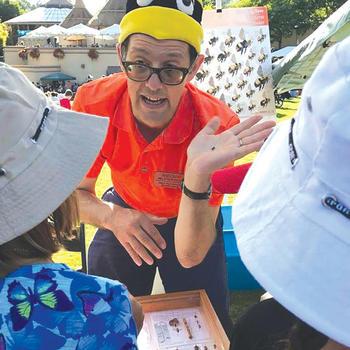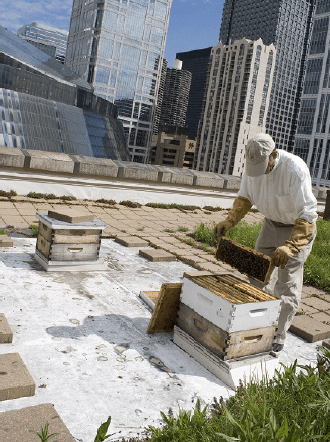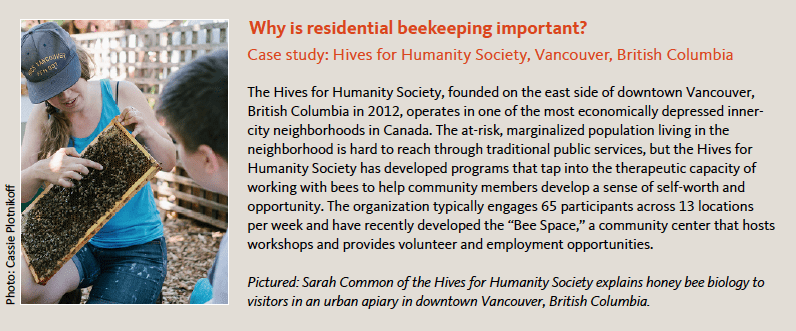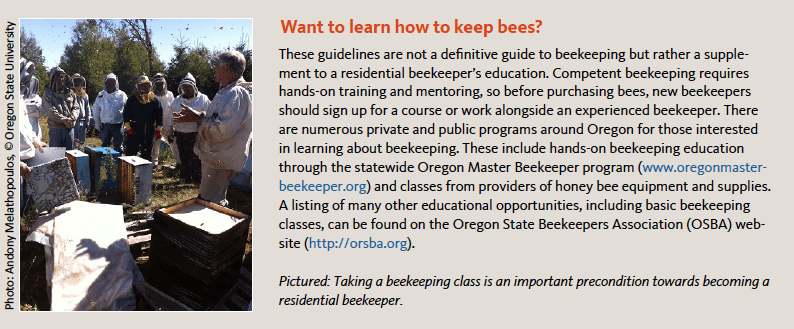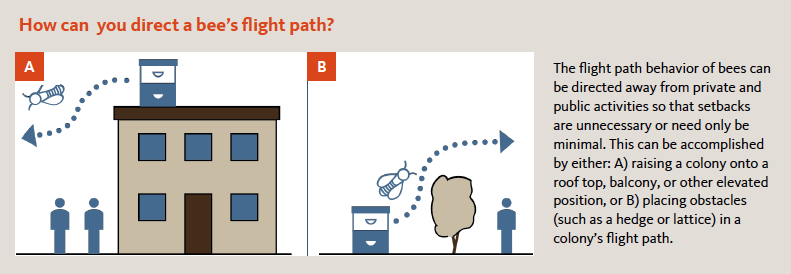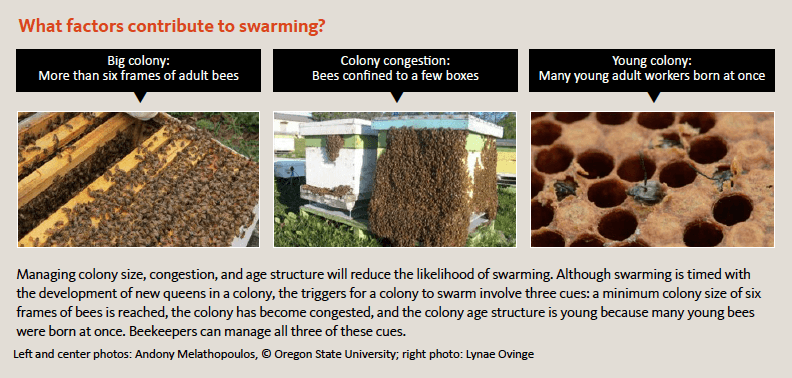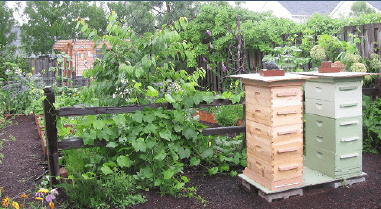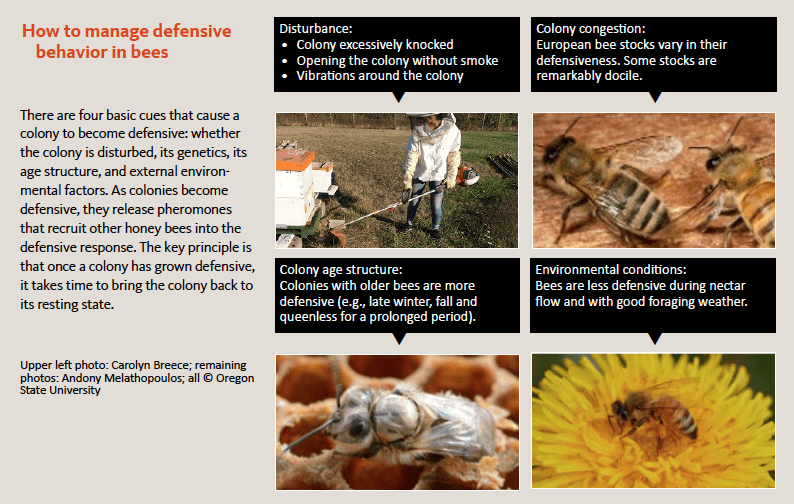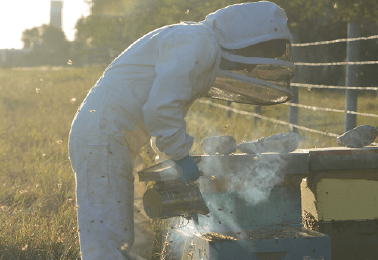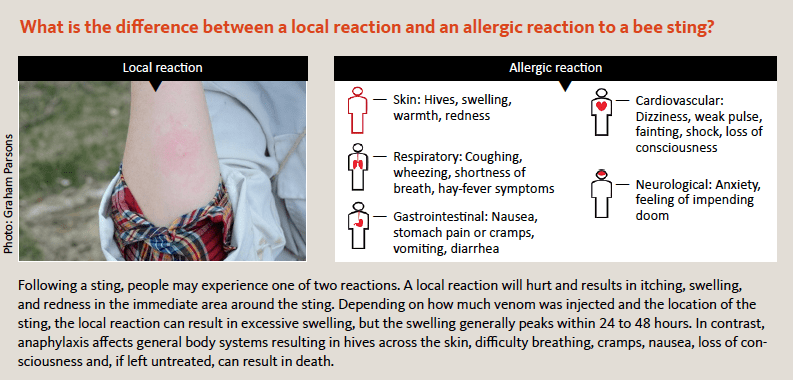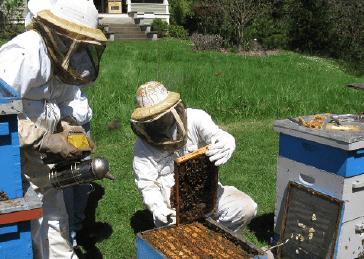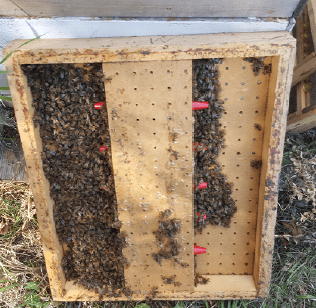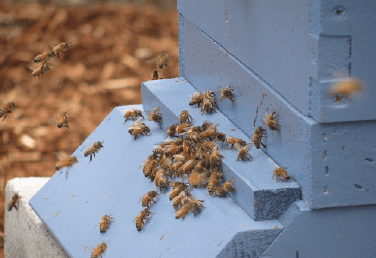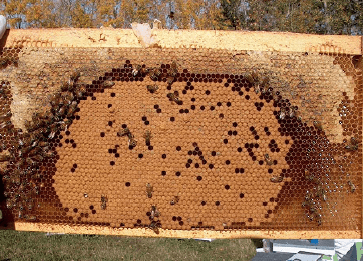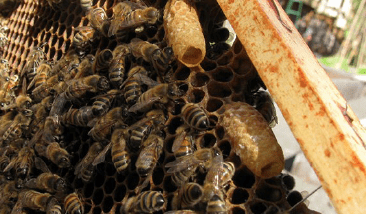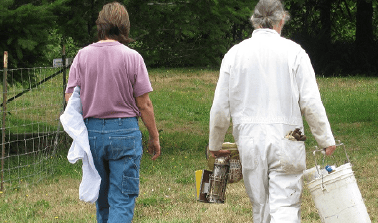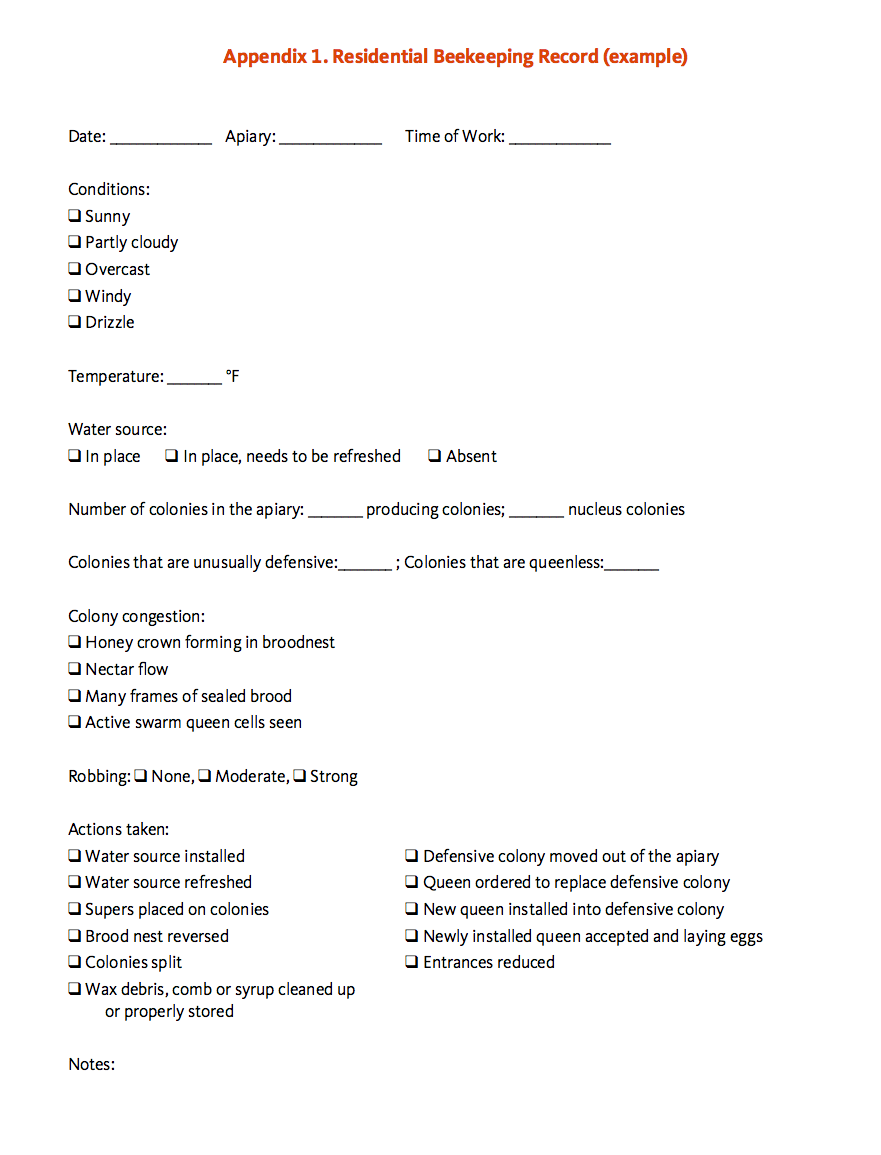Introduction
Why residential beekeeping is important
Many people around the world keep colonies of honey bees in residential areas as a hobby and source of recreation, and as a way to increase backyard garden fruit and seed set. Consequently, honey bees are found everywhere, from the roofs and terraces of public buildings in high-density city cores (Figure 1) to suburban backyards. While residential beekeeping can prove extremely rewarding to the beekeeper (a single colony can produce more than 40 pounds of honey, as well as other valuable products such as pollen, propolis, and wax), it also provides considerable benefits to neighbors and the city as a whole.
Honey bees play an important role in the residential community, providing pollination for the beekeeper’s property and for properties up to two miles away. As cities and towns encourage residential beekeeping and it becomes more established, the benefits increase and become integrated into a number of public services, such as educational projects, income opportunities for under-employed populations, and personal and community-building activities. Many residential beekeepers in Oregon belong to urban chapters of the Oregon State Beekeepers Association (OSBA). Through OSBA chapters, beekeepers provide outreach and education to diverse urban audiences, including making presentations to K-12 classes and staffing information tables at farmers markets, regional fairs, and public field days.
About this guide
Across the United States, some cities and towns do not permit residential beekeeping; some permit beekeeping if the beekeeper adheres to certain restrictions; and others permit beekeeping with no restrictions, provided the beekeeping does not become a public nuisance. In 2015, the Oregon legislature signed House Bill (HB) 2653 into law to address loss and/or decline of many pollinator species (including honey bees), the growth of residential/urban beekeeping, and the need to regulate it.
The intent of HB 2653 is for Oregon State University to develop guidelines for best practices that, if followed, would ensure beekeeping activities do not develop into a nuisance. The best practices guidelines would make it possible to use existing local nuisance ordinances instead of new legal restrictions for managing conflicts that arise from beekeeping in residential areas. By January 1, 2019, local governments will review and consider these best practices guidelines, along with existing ordinances, and decide whether or not to adopt new ordinances relating to residential beekeeping.
This publication outlines the guidelines for best practices. It is designed to supplement beekeeping education by making people aware of specific management practices that greatly reduce the risk of residential beekeeping turning into either a private or public nuisance. Beekeepers who follow and document the use of these practices will help address the concerns that neighbors, the public, and local government officials have about residential beekeeping activities. Public officials, the general public, and others interested in learning about honey bees can also use these guidelines as a source of information about the kinds of steps residential beekeepers can take to operate their bees in nuisance-free manner. These guidelines do not address the issue of Africanized honey bees, which have not been documented yet in Oregon. Nor are these guidelines intended to cover the management of mason bees, bumble bees, yellow jackets, or other insects. These best practices guidelines cover three broad sections:
1. Key concepts for nuisance-free residential beekeeping
2. Specific practices to reduce nuisances of residential beekeeping
3. Legal considerations for residential beekeepers and guidelines for local governments
Nuisance-free honey bee beekeeping
The legal definition of a nuisance goes beyond the everyday meaning of being bothersome. Legally speaking, an activity becomes a nuisance when a person’s use of or activity on a property infringes on the rights of another person’s property (private nuisance) or on the rights of the general public (public nuisance). This infringement might be anything that:
• Is considered harmful to public health, safety, or convenience;
• Impedes the ability of people to enjoy public or private property; or
• Lowers the physical condition or value of surrounding property.
In this sense, honey bees and beekeeping are not legally a nuisance but can become a nuisance if a person fails to manage their honey bees properly.
The recommendations in this document reflect our best understanding of honey bee biology and colony management. When followed, they will significantly reduce the risk that residential beekeeping activities will develop into a nuisance. These best-practice guidelines do not constitute hard and fast rules, as the conditions under which honey bees may become a nuisance vary, depending on a number of circumstances. Rather, when considered together, these guidelines will help beekeepers develop the skills and judgment to minimize the risk that their honey bees will interfere with a neighbor’s and/or the public’s right to enjoy their private and public spaces. With judgment and care, residential beekeeping is an activity that enhances everyone’s overall experience of the city and its outdoor spaces.
Key concepts
The honey bee’s flight path
The first consideration for practicing nuisance-free beekeeping is deciding how far a colony will be located from a neighbor’s or the public’s property (i.e., the amount of setback). Distance alone does not account for the honey bee’s flight path; bees do not fly at a consistent height or always in straight paths. The foraging flights of honey bees begin at the colony exit/entrance. The colony can be located anywhere between ground level and the top of a building. If the colony is at ground level, the foraging honey bees typically fly to a height above that of the average person within a few feet of the exit/entrance. If the colony is elevated, the foraging honey bees will begin their forward flights above ground level. As bees travel about 10 feet from the exit/ entrance, their numbers quickly thin out as they disperse in a wide area and to higher heights.
Honey bee water foraging
Water has two uses in the colony. The first is to cool the colony, and the second is to thin stored honey. Honey bees will seek out water wherever it is available, whether in a bird bath or other water feature, swimming pool, runoff, or a water source provided by the beekeeper.
To cool the colony, bees disperse water through the colony’s brood nest. Fanning (the rapid movement of the wings of many bees) at the colony entrance increases the evaporation and cooling power of the dispersed water. In the spring and summer, when daytime temperatures increase, foragers begin looking for sources of water. Unlike honey and pollen, water is not stored in the colony and must be collected when it is needed. Therefore, water demand in a colony can occur quickly in response to abrupt swings in temperature.
Water foraging to dilute stored honey is largely restricted to early spring, before the first major honey flow begins. Consequently, foraging for water to dilute nectar decreases as soon as fresh nectar becomes available.
Swarming
It is a natural process for part of a parent colony to split and relocate; however, many people become concerned when they see a honey bee swarm in flight or when they find one settled on their property (e.g., in a tree or under their house eaves). Honey bee swarms are not aggressive. They are only looking for a new home and may pause temporarilyin their flight before moving on (Figure 2). Using proper colony management techniques, beekeepers can decrease swarming by reducing the cues that bees use in deciding whether or not to swarm.
Although swarming is timed with the development of new queens in a colony, the triggers for a colony to swarm involve three cues: a minimum colony size of six frames of bees is reached, the colony has become congested, and the colony age structure is young because many young bees were born at once. Beekeepers can manage all three of these cues.
Defensive behavior
Studies have indicated that most people cannot identify stinging insects with certainty. When they can distinguish between them, the bulk of the stings they report are from yellow jackets or hornets. The lack of confirmed stings from honey bees is because honey bees are generally not defensive. If they exhibit defensive behavior, it is usually restricted to within a few yards of their colony and only if the colony has been disturbed.
Stings and allergies
Honey bees are only likely to sting after they become highly defensive. There are two types of reactions to being stung, a local reaction (e.g., pain, swelling, and redness) and a potentially life-threatening, systemic allergic reaction called anaphylaxis that can result in throat swelling, shortness of breath, lightheadedness, and low blood pressure. Most people experience a local reaction to a bee sting. Estimates, based on self-reported data, suggest that 0.3% to 7.5% of all insect stings result in a systemic anaphylactic reaction, with lower rates reported for children (0.15% to 0.3%) (reviewed in Biló, et al. 2005).
While anaphylaxis can prove fatal if not immediately treated by a health care professional, the incidence of insect sting-related deaths (hornet, bee, and wasp stings combined) in the United States remains very low (0.195 per million) (Forrester, et al. 2012). Deaths attributed to insect stings in northern states such as Oregon are lower than the national average (Forrester et al. 2012). Systemic reactions can also develop from other stinging insects, such as yellowjackets, hornets, and bumble bees. Since the public may not be able to differentiate these species (Ratnieks, et al. 2016), many self-reported bee stings are likely caused by social wasps (Barr 1974).
Robbing
Foraging honey bees typically fly from their colony to flowers to collect nectar and pollen and rarely visit neighboring colonies. This pattern gets disrupted in late summer and early fall when the flowers begin to fade and the foraging honey bees turn their attention to other colonies or non-floral sources of sugar (e.g., spilled sugar syrup or rotting fruit on the ground). Honey bees that rob can become defensive. In addition, the searching behavior of robbing honey bees can result in the honey bees becoming a nuisance for neighbors. Foraging honey bees will seek out weaker colonies to steal their honey, leading to a defensive response by the weaker colony, which can also result in a nuisance for neighbors. Robbing behavior is distinctive—honey bees can be seen fighting on the ground, or a frenzied group can rapidly appear if a comb of honey is left out of the colony or if syrup, nectar, or honey is spilled on the ground.
Strategic practices to reduce honey bee nuisances
Become an educated beekeeper
New beekeepers should attend a local beekeeping association’s “Bee School” to learn what is necessary to manage honey bees and gain hands-on experience before receiving their packages or nucs of honey bees. Because beekeepers need to order honey bee packages or nucs, the bees may arrive before the beekeeper has had the chance to attend a course. As such, beekeepers- in-training should begin with one to two colonies until they develop their skills.
It is important for new beekeepers to become competent in handling frames in a gentle manner. This skill is rarely learned without the assistance of a hands-on mentor. Many of the regional associations of the Oregon State Beekeepers Association (OSBA), along with the Oregon Master Beekeeper program, offer mentoring opportunities that are particularly well suited to helping new beekeepers learn to work gently with bees.
Siting your apiary properly
• Consider sun and wind exposure: Place colonies where they will get first light and sun for most of the day. If possible, the colonies should face southeast. Windbreaks are highly desirable. If windbreaks are not possible, colony lids should be weighted with rocks or bricks (Figure 3).
• Space between colonies: Separate colonies so that the beekeeper can work comfortably to the side of one colony without bumping into and disturbing an adjacent colony. Adequate space between colonies will also minimize the likelihood of bees drifting between colonies.
• Locate away from sensitive areas: Do not locate bees directly adjacent to high traffic public areas or an area frequently used by neighbors unless the flight path has been blocked by a barrier (see “Honey bee flight path barriers”).
• Do not block emergency access: Do not place colonies in the path emergency workers would use to access the property (e.g., a side yard).
• Security: Restrict visibility of the apiary and the public’s access to it.
• Provide access: Be sure you are able to move equipment and honey bees into the apiary in a secure and safe manner. Apiaries elevated from the ground may require special considerations for sealing and securing equipment.
• Get permission: If you plan to put your honey bees on property that is not your own, make sure to get the owner’s permission and make them aware of any legal and liability implications.
Honey bee flight path barriers
The flight path of honey bees can be altered to reduce or eliminate people’s contact with them within a few feet of the apiary. There are two ways of altering the honey bees’ flight path:
• Elevation: Elevate the apiary to more than 10 feet above where people are (Figure 4).
• Barriers: Place a barrier (6 feet or higher) between the apiary and an adjoining property (Figure 5).
In both cases, honey bees are far less likely to become defensive to activity on the other side of the barrier or at ground level and will leave the colony at a height above neighboring properties.
Solid barriers offer the most benefits, although the flight path of foraging bees is still disrupted by porous lattice walls, hedges, and other obstacles. The barrier should extend approximately 10 feet on either side of the apiary; however, this distance may need to be adjusted depending on the situation.
Number of colonies per apiary
Beginning beekeepers should restrict the number of their colonies per apiary to one to two colonies, until they are confident in managing colony defensive behavior. Beekeepers may expand their apiary as they develop experience and confidence. There are no studies that link a precise number of colonies to whether an apiary will develop into a nuisance or not. How defensive honey bees are outside of a property depends on multiple factors, such as apiary location and topography, the density of the residential neighborhood, and the density and maturity of vegetation in the area (e.g., old big trees). Experienced beekeepers should therefore add additional colonies gradually and regularly walk around the periphery of the property to assess whether the apiary has become overstocked and monitor for defensiveness.
Honey bee access to water
To prevent honey bee nuisances that arise from their need for water, create attractive alternatives to other sources of water that are not on the apiary property. Maintain access to the water source throughout the water foraging season. To create water source that is attractive to honey bees:
• Establish the water source early: For best results, provide the apiary water source early in the spring, before the honey bees start searching for water.
• Maintain a water reservoir: Never allow the apiary water to go dry during the water collection months. If this happens, the bees will seek out another source of water and may not return to the apiary water source. If this happens, the honey bees could potentially develop into a nuisance.
• Use floats: To prevent water-seeking honey bees from drowning, put floats or other landing objects in open pools, bird baths, tubs and other containers. Pebbles, corks and floating items of wood, straw, or plastic can be used for these platforms (Figure 6).
• Change water: The apiary water should be changed frequently to avoid stagnation and mosquito breeding. Changing the water may not be necessary if the apiary water source has a spigot or hose that slowly allows fresh water to drip into the source container.
Working the honey bee colony
It is important to be gentle when working with honey bees. Avoid jerky movements and jarring the colony, which could cause honey bees to become defensive and a nuisance. A beekeeper needs to use a properly lit smoker when opening the colonies, continuously applying smoke in a judicious manner until the colony is closed. Because effective use of these techniques is a cornerstone of residential beekeeping, new beekeepers should practice them under the guidance of an experienced beekeeper.
The following guidelines for working around colonies will significantly reduce a colony’s inclination to become nuisance:
• Work gently and work with smoke: Beekeepers should learn to work colonies in a smooth manner. They should learn to light, maintain, and use a smoker from an experienced mentor (Figure 7).
• Close colonies: The lid on a colony should not be left off for more than 10 minutes. If the beekeeper is called away by another task (e.g., answering the phone) they should always close the colonies before tending to that task.
• Close up when colonies become defensive: If the beekeeper is working with multiple colonies and notices heightened defensiveness, they should close the colony they are working on and discontinue working any of the colonies for the rest of the day.
• Arrange colonies in the apiary: Colonies should be arranged so that the beekeeper can work at the side or back of the colony (i.e., not in the honey bee foragers’ flight path) and without bumping adjacent colonies (Figure 8).
• Work when people are absent: Beekeepers should not work colonies when people are within 10 feet of the colonies, unless they are wearing protective beekeeping equipment, behind a barrier or well below an elevated apiary (see section above “Honey bee flight path barriers”).
• Work bees when they are flying: Beekeepers should work honey bees between mid-morning and mid-afternoon, when most of the foragers are away from the colony and busy gathering nectar and pollen. They should avoid opening colonies at dawn or dark.
• Stay out of colonies in poor weather: Beekeepers should not work colonies during adverse weather (e.g., cool and damp weather or when a storm is coming).
• Stay out of colonies during nectar dearth: Beekeepers should avoid or minimize working bees during a nectar dearth (i.e., shortage of available nectar from blooming plants). See “Robbing.” If it is absolutely necessary to work colonies, beekeepers should limit these entries to days with cooler weather.
• Requeen defensive colonies: If a colony is particularly defensive, beekeepers should replace the queen (queens are generally available for purchase from April to July).
• Extract honey: Bees should be separated from honey supers in a way that prevents them from becoming defensive. Honey bee escapes provide one of the best options for residential beekeepers to remove honey (Figure 9). Beekeepers should avoid removing honey bees by blowing them from the colony using a powered “bee” or leaf blower; this greatly disturbs the colony. Gently shaking and brushing honey bees from comb is acceptable, but it can be a slow process and may result in the colony becoming defensive.
• Avoid mowing grass around colonies: Honey bees can become particularly defensive when lawn is cut within a few feet of the colonies, particularly if the cutting is done with an electric or gas-powered trimmer or edger. Beekeepers should use less disruptive methods for lawn management in the apiary and consider cutting grass around colonies as close to dusk as possible.
Robbing and beekeeping equipment storage
Properly storing comb, colony boxes, and unused frames with wax foundation helps reduce the risk that honey bees will develop into a nuisance. Good storage practices restrict bees’ access to equipment and help ensure it does not attract honey bees and other stinging insects outside the apiary site, which can become a particular problem when honey bees stop foraging and begin robbing. Robbing frequently coincides with the removal of honey supers late in the season. As highlighted below, colonies should be worked sparingly after colonies begin to rob.
The following guidelines will significantly reduce honey bee attraction to stored equipment and robbing:
• Store equipment in a building that excludes bees: Outdoor equipment storage should not be used except as a temporary measure and never when bees are robbing.
• Limit exposure of comb: Beekeepers should avoid working colonies when bees are robbing. If the beekeeper has to inspect a colony, exposure should be minimized by carefully covering exposed comb with moist burlap or a hive cover.
• Dispose of wax and debris: Pieces of wax that are removed from colonies should be taken from the bee yard and stored. Failure to do so may attract pests, such as skunks, that will attack the colony, eat honey bees, and cause the colony to become very defensive. Clean the ground around the colony after working the colonies by removing and placing wax pieces and other debris in a bucket, and then sealing and relocating the bucket away from bee access at the end of the day.
• Avoid open-feeding of bees: The bulk outdoor feeding of sugar syrup involves filling a bucket, barrel, stock tank, or other container with sugar syrup and providing the bees with a float (out of wood, straw, or other material) to stand on when accessing the sugar syrup. This practice is strongly discouraged for the residential beekeeper; using internal feeders is a better approach. In addition, Boardman-style feeders that fit into the colony’s bottom board should be avoided when colonies begin robbing; these feeders are easily accessed by bees from other colonies, as well as by yellowjackets and hornets.
• Ensure syrup feeders do not leak: Feeders should not leak syrup. If they leak, the sugar syrup needs to be cleaned up promptly by diluting it with water to avoid robbing. The feeders should be removed and repaired or replaced.
• Reduce robbing during honey harvest: After removal from the colony, honey supers should be quickly covered and placed out of reach of foraging honey bees.
• Reduce robbing by reducing entrances: Robbing by other colonies can be curtailed significantly by reducing the size of colony exit/entrances to make it easier for colonies to defend themselves (Figure 10).
Honey bees and skunks
Skunks are insectivores and are one of the few species of rodents that will eat live honey bees at the entrance of the colony. Skunks are an issue for nuisance-free beekeeping. When a skunk disturbs a colony (usually in the evening) and eats the responding honey bees, the colony will be more defensive for the next few days.
It is easy to detect whether a skunk has been visiting an apiary. Skunks typically scratch at the exit/entrance of the colony as a way to locate the weaker colonies and draw the honey bees out. Consequently, exit/entrances and areas in front of the colony are usually muddied or will have visible scratch marks. One might also notice that grass in front of the colony is torn up because skunks may roll around in the grass after being stung.
If a colony is being visited by skunks, the best defense is to elevate the colony off the ground by at least a foot, or to install nail beds or chicken wire guards around the front of the colony. These devices dissuade skunks because their underbellies and paws are very sensitive. Raising colonies at least a foot off the ground also exposes the skunk’s belly to stings as they reach for the colony entrance.
Preventing honey bee swarm
To prevent colonies from taking the initial steps towards swarming, beekeepers should:
• Super colonies early: Beekeepers should place honey supers on top of brood chambers well before the main nectar flow. Moreover, beekeepers should monitor the filling of the super and create additional honey storage space (supers) before the existing super(s) are approximately two-thirds full of honey.
• Reverse brood chamber if brood nest is honey-bound: If the upper brood chamber of a two-chamber brood nest has become honey-bound (filled with honey), then the brood chamber boxes should be reversed before adding any additional super boxes (Figure 11).
• Split colonies in the spring: When the colony is particularly strong and contains large numbers of young bees, the colony should be split before adding additional supers.
Honey bee swarm control
When swarm cells appear, the colony is at high risk of swarming (Figure 12). The removal of queen swarm cells may not be sufficient to prevent a swarm, as the colony will produce new queen swarm cells, and some of these cells may be located where the beekeeper cannot see them. In this situation, the colony will have to be significantly reduced in size by splitting off and moving at least half of the sealed brood and bees and replacing the frames with undrawn foundation.
Queenless colonies/requeening
Ideally, new or replacement honey bee queens should be selected for gentleness. This will minimize defensive/stinging behaviors directed at the beekeeper as well as at neighbors and the public. If a colony has become unusually defensive and is at risk of becoming a nuisance, the beekeepers should:
• Move the colony: The colony should be moved to a location with a lower risk of interacting with neighbors or the public.
• Requeen: Kill the original queen and replace her with a new queen within 24 hours.
Colonies that become queenless are often more defensive as they gradually become populated with older bees. Colonies may lose queens in a number of different ways, including when queens are accidentally crushed by the beekeeper during colony inspection, when they die of old age or disease, or are superseded. Supersedure is a process when the workers decide that the queen is not productive enough and they replace her (Figure 13). Queenless colonies are easily identifiable by emergency queen cells that are added to the face of brood frames within 1 to 2 days of the queen being lost and by the absence of newly laid eggs within 4 days of the queen being lost. If the colony fails to produce a new queen, it will not rear a new queen (such a colony is termed “hopelessly queenless”). A hopelessly queenless colony becomes very defensive and is difficult to requeen. For this reason, it is important to identify queenless colonies early. Requeening can sometimes be difficult; new beekeepers should consult a more experienced beekeeper before proceeding.
Legal considerations for residential beekeepers and guideline for local governments
Honey beekeeper-neighbor interactions
Unless the apiary is located in an isolated area, beekeepers should to talk with neighbors about their residential apiary. In many cases, talking with neighbors about beekeeping before or soon after setting up an apiary helps avoid misunderstandings. However, in some situations, beekeepers may decide that it is best to wait and respond to neighbors’ questions as they arise. Whichever the case, talking with neighbors should be viewed as an opportunity for beekeepers to provide information about the benefits of honey bees and describe the steps they plan to take to ensure their bees do not become a nuisance (Figure 14). In these situations, it is also important that beekeepers listen carefully to their neighbors’ concerns and be prepared to provide well-researched, objective responses. Beekeepers should be prepared to respond to concerns around stinging and refer their neighbors to materials that:
• Show the difference between social wasps and honey bees, as the nuisance may be wasp- rather than honey bee-related
• Provide options for dealing with social wasps (yellowjackets and hornets)
• Outline the differences between a temporary localized reaction and a systemic allergic reaction (anaphylaxis) to stings, and explain the low incidence of anaphylaxis in the population and steps they should take if they are stung
Moreover, beekeepers should be prepared to discuss the benefits of beekeeping in the city. These benefits can be most directly conveyed by making sure neighbors receive a jar of fresh honey from the apiary or pointing out how honey bees pollinate many backyard garden plants, particularly fruit trees and berry bushes. Beekeepers should also anticipate that neighbors will be curious about honey bees. Honey bees are fascinating creatures and have received considerable media coverage in recent years, so beekeepers should make sure to take the time to answer neighbor and neighborhood questions about bee biology and beekeeping. There are many examples of residential beekeepers who become an important community connection to the natural world and agriculture, particularly when the beekeeper communicates openly with neighbors and is diligent in ensuring their bees never develop into a nuisance. As the relationship between neighbors and the residential beekeeper matures, beekeepers will find that neighbors will develop a sense of ownership of the apiary and will, for example, keep an eye out for any potential vandalism of the colonies.
Residential beekeepers should also make sure that they are protected against any damage their honey bees cause to a third party. Not all home insurance policies cover damages associated with residential beekeeping, so the beekeeper should understand their coverage before setting up an apiary.
Honey bee public education/service
Beekeepers should keep their eye out for local opportunities to answer public questions about honey bees, beekeeping, and pollination, particularly at farmers markets, summer festivals, and with school groups. Begin education with immediate neighbors and then expand your outreach, as time permits. The Oregon Master Beekeepers Program trains volunteers who can help beekeepers prepare for education and outreach events and who are also available to talk to neighborhood and community associations and local schools.
Honey bee swarm collection
An important element of neighbor-beekeeper relations is that the beekeeper responds promptly and sympathetically to calls about swarms. Beekeepers should not assume that their neighbors know about swarms and should be prepared to address concerns with reference to swarm biology (i.e., how swarming is the way honey bees reproduce, that swarms are not defensive, and that they are transient and will soon move to another location). The process of swarm collection can be complicated, and swarms in residential areas sometimes land in extremely awkward or difficult places for removal. Catching a swarm can turn into a nuisance if the beekeeper does not know what they are doing or they are not prepared with the right tools for the removal or both. It is advisable that a new residential beekeeper first watch a mentor collect a swarm. If the beekeeper is unable to capture the swarm, they should contact the closest regional Oregon State Beekeeper Association (http://orsba.org) chapter as they typically maintain a listing of beekeepers willing and qualified to remove swarms. Some of these volunteers have extensive experience and are able to, if needed, remove honey bee swarms from nearly any location.
The inexperienced residential beekeeper should maintain a list of the beekeepers located nearby who are prepared to remove swarms. In many cases, local beekeeping clubs will already maintain a list of experienced beekeepers who can do this. The residential beekeeper could refer a call for swarm collection to one of the listed beekeepers or go with them or both, if it is the inexperienced beekeeper’s first time to colony a swarm.
Beekeepers, whether members of the OSBA, its regional associations, or the Oregon Master Beekeeper Program can provide assistance, in most cases without charge, to other beekeepers, the public, and governmental agencies and officials to remove and relocate honey bee swarms that have settled, even temporarily, at an unacceptable site. These beekeepers can be contacted by phone or email through lists maintained by municipal police, fire departments, utility companies, Extension agents, and others. In addition, the OSBA and the Oregon Master Beekeeper Program will provide a list, by local area, of the experts in cities, towns, and counties.
Registration of honey bee colonies
All beekeepers who manage five or more colonies (not including nucs) within the state during the last year are required to register with the Oregon Department of Agriculture (ODA). The registration fee is $10 plus 50 cents per colony, due by June 1 of the current year. There is no grace period, but registration after July 1 of the current year requires a $20 registration fee plus 50 cents per colony. The registration is for one year and must be made with the ODA each year.
In the past, only those beekeepers engaged in commercial pollination services were required to register. The funds collected by the ODA went into the agency’s general operation budget. A new addition to the fee law (ORS Chapter 602) and rules adopted in 2015 require that the registration funds be spent on pollinator research that is predominantly focused on honey bees.
The residential beekeeper with more than five colonies should not ignore the law; it is a legal requirement and has benefits. For instance, registration demonstrates a beekeeper’s diligence should a legal issue arise. In addition, the registrant will receive notifications from the ODA on matters relating to honey bee beekeeping, such as the registration of new mite control agents.
State registration can be completed on the ODA website (https://apps.oregon.gov/sos/licensedirectory/ licensedetail/606) or by downloading and mailing the form to the ODA. Beekeepers can request a hard copy of the application by calling the ODA Pest Prevention and Management Program at (503) 986-4636.
As permitted by Oregon Revised Statues (ORS) Chapter 602.045(2) and 602.090, a local government may charge a reasonable fee for registering colonies in residential areas. That fee may not exceed that charged by the ODA. Although very few local governments charge a registration fee, beekeepers should be aware of this possibility and that it is separate from state registration.
What to do if the residential beekeeper is cited:
• Provide documentation of having followed these best practices guidelines: The beekeeper should keep good records of all colony management activities, including robbing and swarming prevention techniques. The records may help the beekeeper demonstrate due diligence in the event of being cited for a nuisance violation (Appendix 1).
• Get assistance: Unless the beekeeper is clearly in violation and the cited ordinance is reasonable and in accordance with these best practices guidelines and ORS Chapter 602, the beekeeper should contact the OSBA. The OSBA will guide the beekeeper through the citation process.
• Assess the cause of the nuisance and mitigate it: The beekeeper should work with the OSBA and law enforcement to determine the cause of the nuisance and take steps to prevent further nuisance through mitigation measures (e.g., if bees have become defensive because of skunks, install skunk exclusion devices and reassess the bees’ defensiveness to see if it has been reduced).
• Appeal the citation: It is important that the beekeeper know that the issuance of a citation or notice of violation, with or without the imposition or threat of a penalty, is usually a civil proceeding and can be appealed. It is not a criminal process, and there is no threat of jail time. Enforcement officers must be able to justify any citation they issue, and the beekeeper has a right to contest the citation and the justification. An appeal or contest starts by meeting with the enforcement officer or their supervisor or both to see if the issue can be resolved. In some cases, because of the way the ordinance is written or interpreted, it may not be possible to resolve the issue at this level. If it becomes necessary to advance beyond the level of meeting with an enforcement officer (e.g., city council), the OSBA will take the lead.
• Work through existing channels: If the beekeeper receives a citation, they should not make a major protest that involves friends and the press. The beekeeper should recognize that municipal government and officers are doing their best to serve the public and may have little or no background with honey bees.
Glossary
Africanized honey bees: An aggressive tropical race of honey bees that originated from Africa but were introduced to and have expanded through South and Central America, Mexico, and a number of southern U.S. states. The range of Africanized bees does not extend to Oregon.
Apiary: The place where honey bee colonies are located. An apiary is not defined or limited by acreage or lot size.
Apis mellifera: The species name (which is Latin for “honey-producing bee”) for honey bees. It is the only species among the 500 different species of bees in Oregon that produces a surplus of honey.
Bee: Four-winged insects that are often covered in dense hair and meet all their dietary needs from the nectar and pollen from flowers. There are over 500 species of bees in Oregon, and many of them live naturally in cities. Bees are frequently confused with yellowjackets and hornets.
Brood: The common term for the immature stages of honey bees (e.g., eggs, larvae, and pupae). Capped brood refers to pupae covered by a dome-shaped wax covering.
Brood chamber: Any box that primarily contains the queen and frames of brood. A colony typically has one to two boxes. Different from a super (see below) that is used for honey collection.
Colony: A group of honey bees typically consisting of a single queen (a fertile female), thousands of worker bees (sterile females), drones (males) and brood (immature bees of any sex). The colony is the smallest management unit. In the movable-frame system, the nest may consist of multiple boxes of frames stacked vertically. Frequently used interchangeably with the term hive (see below).
Comb: A collection of hexagonal wax cells typically built along a plane, which houses honey, pollen and/or brood. In the movable-frame system, comb is synonymous with the term frame (where a single unit of comb is equivalent to a frame).
Flight path: The route taken by foraging worker honey bees to and from the colony to gather water, flower nectar, pollen, or propolis.
Foraging honey bees: The older adult, worker honey bees that search for and gather food (e.g., nectar or pollen), propolis, or water.
Hive: A container or collection of boxes for housing honey bees. Typically, a human made box with movable frames, but a hive can occur naturally in a tree or other cavity.
Nucleus colony: A small colony that only contains a few thousand honey bees and a queen. A beekeeper uses a nucleus colony to replace a lost colony, strengthen a weak colony, or add a queen to a colony that has lost its queen. It is not considered a production colony and is often referred to as a nuc.
Package: A screened box filled with worker bees and a caged queen (typically shipped in April and May from a southern state, such as California, to Oregon) that is used to start a new colony.
Pollination: The transfer of pollen from flower to flower that typically results in the fertilization of an ovule. Honey bees assist in this transfer as they forage, and many native and garden plants will not yield fruit or produce seeds without honey bee visits.
Production colony: A colony capable of providing pollination services for fruit or seed production or for producing honey, propolis, beeswax, or other bee products.
Robbing: The process by which honey bees collect (steal) honey from colonies other than their own, from frames of extracted honey, or from spills of sugar syrup or honey. They then transfer the stolen honey to their own colonies.
Super: In most movable-frame systems (not including top-bar colony systems) the super is the box or boxes containing frames used for storing honey and is typically placed above the brood chamber.
Supersedure: A collection of honey bees from a colony that has divided. A swarm contains a queen and 30 to 70 percent of the workers, all of which have left the colony to start a new colony elsewhere.
Swarm cells: Prior to swarming honey bee colonies will rear new queen cells, which look distinct from the cells containing work or drone brood.
Resources
An updated list of resources on residential beekeeping, as well as a PDF version of these best-practice guidelines are available online at http://residentialbeekeeping.org
Key websites
Oregon Bee Project: oregonbeeproject.org
Oregon Department of Agriculture, Bees and Apiaries: www.oregon.gov/ODA/programs/IPPM/InsectsSpiders/Pages/BeesApiaries.aspx
Oregon Master Beekeeper Program: extension.oregonstate.edu/mb/
Oregon State Beekeepers Association: orsba.org
Oregon State Beekeepers Association (local branches): orsba.org/branch/
Oregon State University Apiculture Program: honeybeelab.oregonstate.edu/
Oregon State University Residential Beekeeping: http://residentialbeekeeping.org
Beekeeping classes and workshops
Oregon Master Beekeeper Program: A comprehensive beekeeping training program that is a collaboration between Oregon State University and the Oregon State Beekeepers Association. The program includes beginner (Apprentice), intermediate (Journey) and advanced (Master) levels that also includes pairing new beekeepers with experienced mentors. See http://extension.oregonstate.edu
Oregon State Beekeepers Association (OSBA): Regional chapters of the OSBA frequently host “Bee School.” A listing of upcoming classes is available on the OSBA website: https://orsba.org/events/categories/class/
Private Classes: A number of private organizations also offer beekeeping classes. These include beekeeping supply companies, local community organizations, and local beekeepers.
Beekeeping instructional books
Canadian Best Management Practices for Honey Bee Health. Bee Health Roundtable: http://www.capabees.com/canadian-best-management-practices-for-honey-be… 2016
The Beekeeper’s Handbook Alphonse. Avitabile and Diana Sammataro, Cornell University Press, 2006
The Backyard Beekeeper: An Absolute Beginner’s Guide to Keeping Bees in Your Yard and Garden. Kim Flottum, Quarry Books, 2010
Beekeeping instructional videos
An Introduction to Beekeeping. Bee Informed Project (2014)
Equipment Description: https://www.youtube.com/watch?v=HaIidPJMJus
Opening Colonies: https://www.youtube.com/watch?v=NXwVbXKtlNY
Honey Bees and Beekeeping (1993), University of Georgia (25-part series) https://www.youtube.com/playlist?list=PLMne7FXm7S4X1hTXMal4VYtus-Ckf0Ag…
Beekeeping and the law in Oregon
Oregon Legislature House Bill on Residential Beekeeping Guidelines (2015): https://olis.leg.state.or.us/liz/2015R1/Downloads/MeasureDocument/HB2653
Registering colonies with the Oregon Department of Agriculture (5 or more colonies): https://apps.oregon.gov/sos/licensedirectory/licensedetail/606
Beekeeping supplies
Bridgetown Bees: www.bridgetownbees.com
GloryBee (Eugene): glorybee.com
Ruhl Bee Supply (Wilsonville): www.ruhlbeesupply.com
Nectar Bee Supply at Shonnard’s Nursery, Florist and Landscape (Corvallis): www.shonnards.com
Oregon Bee Store (Eagle Point): oregonbeestore.com
Information for homeowners
Inviting Bees to Your Property: No Fear of Stings. Pollinator Partnership
Common Stinging Insects: Wasps and Bees (Bulletin 248). University of Maryland Extension
Homeowner Guide to Yellowjackets, Bald-Faced Hornets and Paper Wasps (Bulletin 852 ). University of Idaho Extension
References
Barr, S. E. (1974). Allergy to hymenoptera stings. Jama, 228(6): 718-720.
Biló, B.M., Rueff, F., Mosbech, H., Bonifazi, F. and Oude Elberink, J.N.G., 2005. Diagnosis of Hymenoptera venom allergy. Allergy, 60(11):1339-1349.
Burgett, M., et al. (1978). Perspectives in Urban Apiculture in Frankie G.W., Kohler C.S., (eds.), Perspectives in Urban Entomology. New York, NY, Academic Press: 187-219.
Forrester, J.A., Holstege, C.P. and Forrester, J.D., 2012. Fatalities from venomous and nonvenomous animals in the United States (1999–2007). Wilderness & Environmental Medicine, 23(2):146-152.
Garbuzov, M. and F. L. Ratnieks (2014). Lattice fence and hedge barriers around an apiary increase honey bee flight height and decrease stings to people nearby. Journal of Apicultural Research, 53(1): 67-74.
Ratnieks, F. L., Schrell, F., Sheppard, R. C., Brown, E., Bristow, O. E., & Garbuzov, M. (2016). Data reliability in citizen science: learning curve and the effects of training method, volunteer background and experience on identification accuracy of insects visiting ivy flowers. Methods in Ecology and Evolution, 7(10), 1226-1235.
Acknowledgements
Andony Melathopoulos, pollinator health Extension and assistant professor; Jen Holt, Master Beekeeper Program coordinator; and Ramesh Sagili, associate professor; all of Department of Horticulture, Oregon State University; and Ralph (Mike) Rodia, Oregon State Beekeepers Association
The authors would like to extend their greatest appreciations to the members of the committee who contributed their time and efforts towards the development of these best practices guidelines. The members include: Max Kuhn; Raine Lee Ritalto; Joe Maresh; Sarah Red-Laird, MS; Dick Temple; Fred Van Natta and Harry Vanderpool. We thank Rita Ostrofsky for feedback on an advanced draft and Rosanna Mattingly for extensive proof reading. A very special recognition extends to Raine Lee Ritalto because, without her concerns and committed efforts to address the issues of residential beekeeping, these best-practice guidelines would not exist. Her efforts led to the 2015 adoption of House Bill 2653 and the subsequent codification of residential beekeeping into Oregon law.
This information is provided for educational purposes only. If you need legal [or tax] advice, please consult a qualified legal [or tax] adviser.
Trade-name products and services are mentioned as illustrations only. This does not mean that the Oregon State University Extension Service either endorses these products and services or intends to discriminate against products and services not mentioned.
Use pesticides safely!
- Wear protective clothing and safety devices as recommended on the label. Bathe or shower after each use.
- Read the pesticide label—even if you’ve used the pesticide before. Follow closely the instructions on the label (and any other directions you have).
- Be cautious when you apply pesticides. Know your legal responsibility as a pesticide applicator. You may be liable for injury or damage resulting from pesticide use.
© 2018 Oregon State University.
Extension work is a cooperative program of Oregon State University, the U.S. Department of Agriculture, and Oregon counties. Oregon State University Extension Service offers educational programs, activities, and materials without discrimination on the basis of race, color, national origin, religion, sex, gender identity (including gender expression), sexual orientation, disability, age, marital status, familial/parental status, income derived from a public assistance program, political beliefs, genetic information, veteran’s status, reprisal or retaliation for prior civil rights activity. (Not all prohibited bases apply to all programs.) Oregon State University Extension Service is an AA/EOE/Veterans/Disabled.
